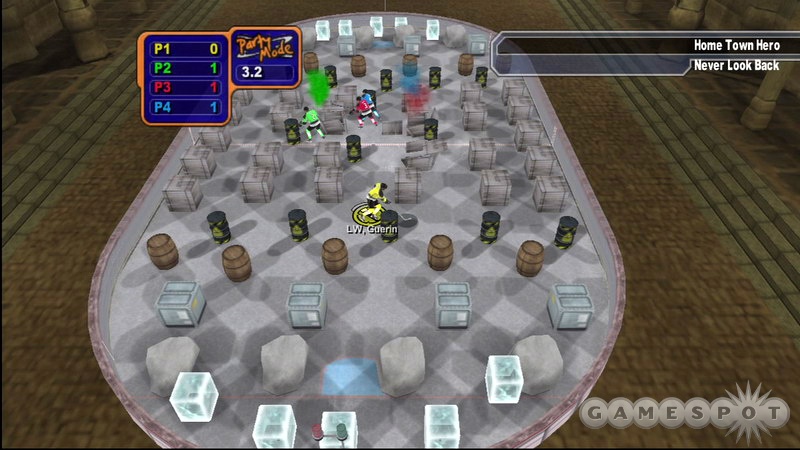NHL 2K6 on the Xbox 360 does not bear quite the same resemblance to its NBA counterpart, which was also recently released just prior to the system's launch. Whereas 2K Sports went to a great deal of trouble to overhaul that game's graphics and animations, that level of effort isn't nearly as apparent in this port. The requisite smoother-looking, somewhat more detailed player models, ice, and whatnot are all on hand, but even with this game running in HD, it's tough to say that this is the next generation of hockey gaming. In fact, the only thing that separates this version of the game from the Xbox and PlayStation 2 versions is a solid new iteration of the goalie control feature implemented this year--well, that and its $60 price tag, three times what you'd pay on the other two platforms. Still, there aren't any other hockey games available for the Xbox 360 this year, and the gameplay is still as fantastic as it's ever been. But out of the three versions currently available, this isn't necessarily the ideal version to get.
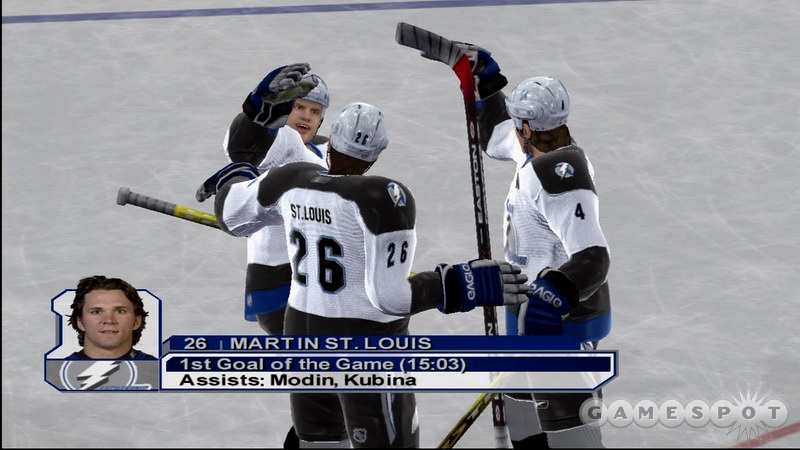
In case you haven't already played 2K6 on another platform, here's what you need to know. For this year's game, the developers have actually thrown together quite a number of new gameplay features compared to last year's version. We say thrown together, because in some ways the gameplay feels more chaotic due to all these new components, some of which are excellent, and some of which are not. Starting with the positives, the best new aspect of the game is the new pro control passing system. One of the problems with setting up good plays in hockey games has been trying to accurately pass to all the right players in a proper succession. This has been nearly impossible with the standard passing mechanics. Here, you can simply click the right analog stick, and button icons will appear above each of the other four players on the ice. You need only press the corresponding button, and the pass will be sent to the right player. This gives you the ability to create lengthy strings of passes that can be especially effective on power plays. The defensive artificial intelligence won't let you pull these plays off easily, of course, but if you can get past them, you can pull off some extremely satisfying goals. The one annoying thing about this feature is that you have to re-click the button to bring up the icons after every shot attempt. Maybe an option to just leave them on indefinitely would have been a good idea. But, even with this one minor gaffe, the feature is great.
Another great idea added into this year's game is on-the-fly play calling. The D pad is utilized here to let you tell your team exactly what you want it to do. This works on both offense and defense, and by pressing specific directions you can have your team do everything from crash the net and screen the goalie to clearing the front of the net and collapsing. When these plays work, they're immensely effective, as the AI does pretty much exactly what you tell it to do. We did run into some instances, though, where it seemed like defensemen in particular weren't quite doing their part on offensive plays, like crashing the net. They definitely come in closer when you ask them to, but they still hover very close to the blue line inside the offensive zone, and trying to utilize them without controlling them directly can be a hassle. But apart from these hiccups, the new play-calling system is a welcome addition.
Yet another good idea that isn't perhaps as well-put-together as it could have been in this year's game is the new enforcer system. Every NHL team has at least one serious tough guy who loves to intimidate the other team's players through rough play and occasional brawls. NHL 2K6 calls these players out by slapping a fat E icon on them that's impossible to miss while you play. If your enforcer does his job especially well while he's on the ice, then opposing players may become intimidated, which is denoted by a big I icon for said player. Intimidated players will also take hits to their stats, most noticeably speed, for some reason. It's kind of odd that a player frightened by the presence of an enforcer would suddenly slow down--if anything, you'd think he'd want to speed up to stay out of the enforcer's way. Apart from that weird bit, the mechanic makes sense and works. The unfortunate thing, however, is that there's never any recourse. The enforcer from the team with the intimidated player never comes out and tries to start a fight--at least, not on the default settings. Fights are incredibly rare in the game, and when they do happen, they aren't much fun. Then again, 2K's fighting model has never been very good, although fights should still happen with far more frequency than they do in 2K6.
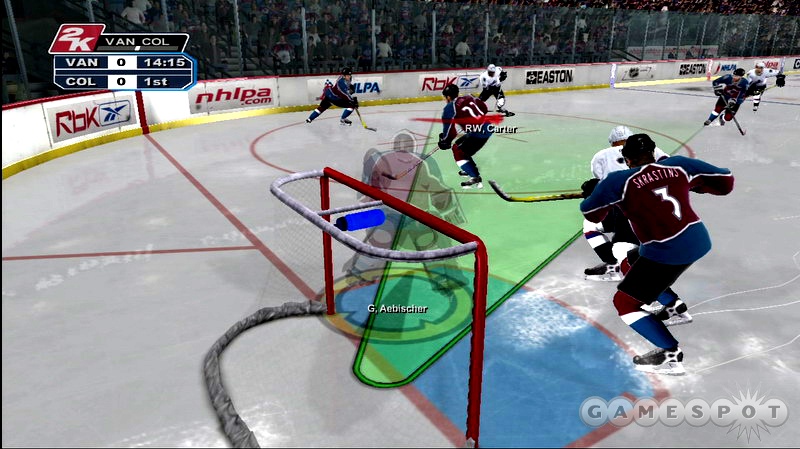
The last big change happened to be the most incidental on the previous two platforms: goalie control. It was a fairly basic system in the previous two versions, letting you use the right control stick to push your goalie into different stances and save types, and hold down a trigger button to automatically position yourself. Neat idea, but not one that was fully fleshed out, it seems, and it wasn't much fun. This system still exists in the aforementioned fashion on the 360, but there's also a whole new version of it that's far more involved and enjoyable. By clicking the right control stick button when in control of the goalie, you'll go into a third-person view behind the net. The goalie becomes somewhat transparent at this point, but you'll still be able to see him and where he's positioned. In front of you is a V-shaped vision cone of sorts that represents your goalie's position to the puck. When the cone is red, that means you're out of position to the puck. When the light's green, the trap is clean, so to speak.
When someone actually takes a shot at you, provided you're in position to deal with said shot, time slows down, and you'll see a little target icon in the back of the net that shows where the puck is headed. You have your own save icon you then move to as close as you can to the target icon. Hit it, and you'll make the save. If you're seriously out of position, you can tap the right control stick to make a diving save. It's less precise, but it can help you in a tight squeeze. The whole system isn't exactly geared towards realism. When in the third-person goalie perspective, the puck has this red glow around it that gives you a better view of where it's moving, and the whole slow motion thing...well, that isn't realistic. But it's also a lot more fun than it would be if 2K had just gone for straight realism, since, you know, you can actually make saves this way.
The one thing that's still a pain in the ass, however, is trying to switch between the goalie and skaters. There's no quick, one-button "snap to the goalie" function, so you'll need to switch around players a fair bit before you can actually get to the goalie, which can often be too late. Also, during multiplayer games, a little picture-in-picture window will pop up when it's goalie time, and that's just disconcerting as all get-out. What you can do is lock your control to the goalie exclusively for a game, which does away with the whole switching issue. But that tends to lead to dull spots where you're not really doing much. Still, it's a lot better than trying to aimlessly switch between players. Ultimately, the point is that this is a cool feature, and with some more interface tweaking and fixes, it could be an amazing one in the future.
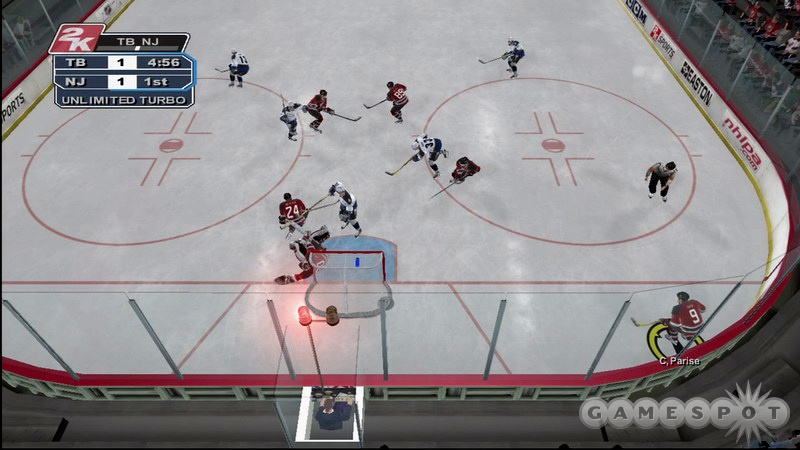
With all these changes and additions and tweaks to the gameplay, some might be wondering if the core game still feels as solid and realistic as it has in past years. The answer is absolutely yes. The pacing still feels completely perfect, moving fast at all the right times and generally feeling like a real game of hockey with lots of back-and-forth action. Realistic numbers of shots, goals, points, and practically every stat you can think of are typically on the postgame boards. The game still doesn't do a particularly good job of getting all your lines involved automatically, but tweaking the setting to manual line changes is all you need to do to correct this. All the new rule changes are in full effect, and this version of the game includes an updated roster with nearly all the active rookies (minus a couple of recent call-ups, like Ryan Whitney). All told, 2K has delivered another extremely realistic and exciting game of hockey on the gameplay front. Though some of the changes might rub some people the wrong way, the overall flow of the game is as fantastic as it's ever been, and the AI can really be some of the most challenging out there when you up the difficulty.
For 2K6, the developers have put together yet another very deep roster of modes that was a ridiculous steal for the $20 price tag on other platforms. It's certainly not a steal for $60 on the 360, but there's definitely no shortage of content here. The franchise mode by itself would be worth such a price. All the great features from last year, like international rookie scouting, contract negotiations, and staff communication are joined by a new practice mode and team chemistry. Practice mode lets you set up individual practices for your players, put together group scrimmages for the purposes of upping chemistry, and create individual skill drills for bonus stat upgrades. Practicing ties into the new fatigue system. Players, like in real life, will now become fatigued if they're overworked, so you'll need to strike a careful balance between how hard you practice them and how much game time they'll see during a week.
As for the chemistry system, it's not unlike the system that was introduced in EA's NHL 2005 last year. Players are broken up into four categories: scoring, skating, hard-nosed, and utility. Like the EA system, putting too many players of the same type together just doesn't work. Generally, it's good to have a single skater, a single scorer, and either a utility or hard-nosed player to complement them on a line. Having a line with good chemistry nets stat boosts for those players, and bad chemistry has a converse effect. The system is great, save for one annoying hitch: Sometimes chemistry on a line simply won't work for reasons that just aren't obvious. Part of it may have to do with the game's happiness measurement, which actually tracks how pleased a player is with his overall role on the team--sort of a morale tracker, of sorts. And sometimes players' happiness will just take big dips, even if they're getting significant play time. There's no communication with players via the e-mail system, so it's impossible to see what, if anything, is causing this dip. Fortunately, it's rare that such morale drops actually result in serious problems, but there are times when you may have to trade away a high-ranked player just because you can't make him happy.
For what it's worth, this year's franchise mode progresses like a real hockey season, more so than it ever has before. Trades are frequently offered, especially toward the trade deadline, and pretty much every offer makes sense on some level. For example, you won't see the CPU try to trade you Rick Nash for Aleksander Suglobov, or vice versa. Free-agent bidding works similarly well, and although there's no definitive salary cap, each team has a hard budget that it can't go over, which is just about as good as a signified cap. Over time, rookies develop, older players retire, and things go on pretty much as they ought to. The CPU now actually knows how to auto-fill a line when an injury occurs (making it so you don't have to constantly jump out of a schedule simulation and reformat your lines yourself), and 2K has added in an interest meter for contract signings, which gives you an idea of how interested a free agent is in the money you're offering. These are all good fixes.
Outside of franchise, all the modes that made their respective debuts last year are back once again. Party mode works fundamentally the same, but with some variations. There are 12 minigames in total, several more than in last year's game, but less actually than what was available in the Xbox and PS2 versions of the game. That's not an altogether terrible thing, though. All the games that were so much fun previously are here once again and still enjoyable. Some of the ones cut were the most extraneous of the bunch, it seems (although some of those still remain). It's one thing to have a game where four players compete for one puck and try to score as many goals as they can into a net that has a blocker that goes up and down. It's quite another to have to do the same thing with a bunch of obstacles on the course, and periodically have to scramble to a musical chairs-like target in order to not have your point total drop. Frantic action is certainly what you would want in games like these, but in some cases, it feels like 2K just had to stretch these existing concepts too far to come up with something new. But hey, at least all the old games are still a blast.
Other modes included in 2K6 should sound pretty familiar as well. There's the dream team ladder, where you go up against teams put together by superstars like Marty Turco, Martin St. Louis, Jeremy Roenick, and the like; the skills competitions from the all-star weekend; the skybox mode, which houses all the stats for completed in-game challenges, as well as all your unlockables; and, of course, online play. The online functionality is precisely what you would expect, with basic quick games, tournaments, and league play all available. The lack of ESPN licensing hasn't prevented 2K from building a Web site stat-tracking system similar to last year's game, so you'll still have access to all those goodies. The online play itself works functionally the same as it always has, so while our mileage may have varied, all the games we played online were smooth and ranked properly. The one serious downside to the online, however, is the menu system. Simply put, this menu system is completely unintuitive and just plain weird. Certain button functions just don't do what they seem like they ought to, and other times completely random buttons will do key functions. For instance, if you get a challenge while sitting in a lobby, the only way to access it is by pressing down on the right analog stick to bring down a previously hidden menu, and the text denoting this is barely visible.
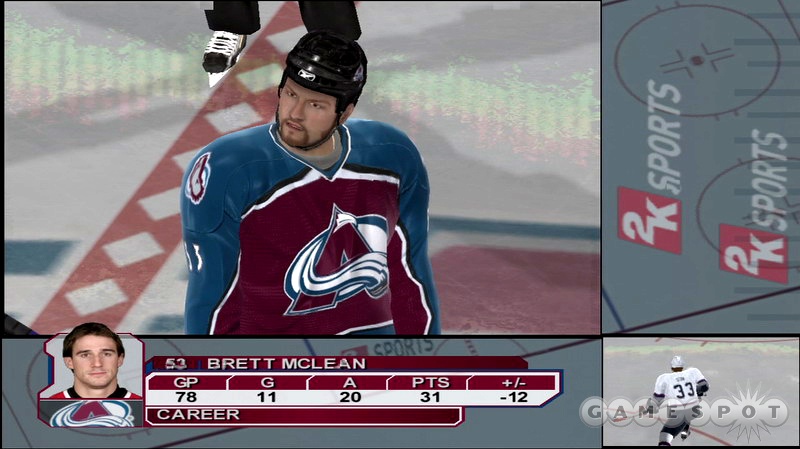
The online menus aren't the only ones that suffer from being terribly confusing. Even during the ESPN days, NHL 2K's menus have had problems, and this year they're exacerbated by the lack of a definitive look and feel. Button functions sometimes simply don't do what you would intuitively think they would, most of the stat and option menus in the game are just plain ugly, and everything has a kind of hacked-together feel to it. You can certainly get around the menus, but it's more of a pain than it ought to be. Incidentally, a few of the menu navigations have been cleaned up from the versions seen on the Xbox and PS2--but only a few of them, and overall everything's still pretty cluttered.
That's basically an accurate description of the in-game graphics, too. Some improvements have been made to the way this game looks on the 360, but without an HD setup, you might as well be playing the Xbox version of the game. And even in HD, the differences are subtle at best. You'll certainly see more detail in player faces and jerseys up close, and the ice does look really damn good, especially from the goalie perspective, because that's a lot closer to the ice than most camera views. But again, you don't see most of this stuff when you're just playing the game. Replays and cutscenes are where you get the most out of these visual upgrades, and those aren't the bulk of the game. There are no real animation differences that are immediately apparent, so you're basically watching the same action you'd be seeing in either of the other versions of 2K6. So while you'll get better graphics in this version, these are definitely not next-gen-caliber visuals we're talking about here.
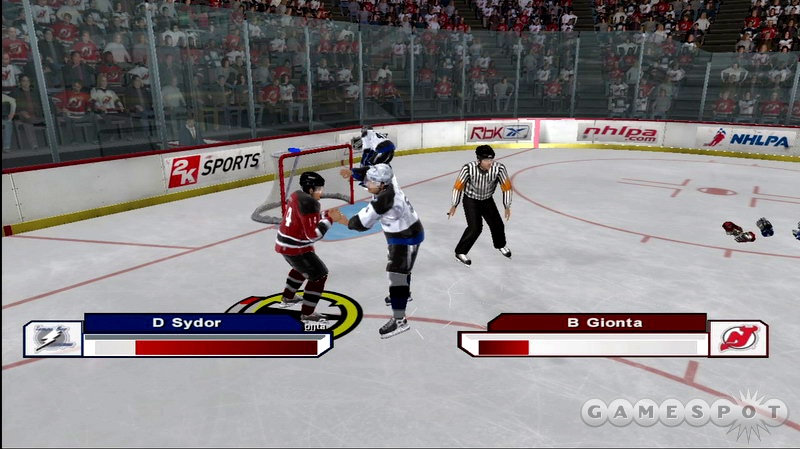
Perhaps the most depressing loss stemming from the ESPN license changeover (as well as ESPN's dropping of all things NHL from its television lineup) is the departure of commentators Bill Clement and Gary Thorne. The twosome delivered some of the best in-game commentary of any sports sim available, and sadly, they've been replaced by a significantly less-interesting team. Hockey Night in Canada announcers Bob Cole and Harry Neale are the twosome in this year's game, and while they're certainly not bad, they lack the kind of cohesive dialogue and rapport that made Thorne and Clement so fantastic. Not to mention that they rarely have anything especially insightful to say, and periodically they'll get things wrong on the play-by-play. Thankfully, the in-game sound effects are still great, from every ping of a puck going off the pipes to the sounds of helpless forwards getting driven into the boards. The soundtrack mainly consists of inoffensive rock music that you've probably never heard before, but it actually isn't too bad.
In the end, NHL 2K6 on the Xbox 360 provides an interesting quandary. Every feature found in the other versions of this game is on hand here, and there are even some improvements, like the new goalie control system. But visually this isn't a particularly impressive game--most certainly not for a game launching with a next-gen console. And the fact that this version costs three times as much as the PlayStation 2 and Xbox games...well, that's a tough sell if there ever was one. If you're dead set on getting this game for your 360, and have no interest in it for other platforms, then NHL 2K6 does deliver enough content and excellent gameplay to make it worth your while. However, less single-minded folk ought to just grab one of the other two available versions. It's a much more thrifty proposition, and you're not missing all that much.
